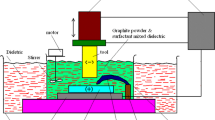Abstract
The aim of the present investigation is to optimize process parameters by mixing various additives in dielectric fluid on EDM of Ti-6Al-4V alloy using Taguchi technique. Span20 surfactant and B4C powder are considered as additives. Span20 surfactant mixed in dielectric fluid degrades the agglomeration of tar debris and powder particles. It also improves the discharge gap and breakdown strength. Five input process parameters were selected, viz. discharge current (Ip), pulse on time (Ton), pulse off time (Toff), B4C powder concentration (B4C Con.) and surfactant concentration (Surf Con.) and varied to explore their performances on Material Removal Rate (MRR), Surface Roughness (SR) and Recast Layer Thickness (RLT). In this study, Taguchi L27 Orthogonal Array (OA) was adopted for planning and designing the experiments. It was observed from the experimental results that the additives in dielectric fluid significantly improved MRR, reduced SR and RLT. Analysis of Variance (ANOVA) test has identified that Ip, Ton and Surf con., are important process parameters affecting MRR and SR; Ip, Ton, Surf con., and B4C con., were highly relevant process parameters influencing RLT. An empirical expression for MRR, SR and RLT was developed by using statistical software. Additionally, surface modification was studied at optimized EDM conditions by using Scanning Electron Microscope (SEM) micrographs.
Similar content being viewed by others
References
ASM International (1993) Introduction to titanium and titanium alloys, properties and selection: nonferrous alloys and special purpose materials. ASM Handbook
Zhang WJ, Reddy BV, Deevi SC (2001) Physical properties of Ti-Al base alloys. Scr Mater 45 (6):645–651
Haron CHC, Jawaid A (2005) The effect of machining on surface integrity of titanium alloy Ti-6Al-4V. J Mater Process Technol 166:188–192
Asokan T, Sudhakar RS, De Costa P (2000) Electrical discharge machining drilling of titanium alloy for aerospace applications. In: Proceedings of the 19th AIMTDR conference, pp 161–165
Lin YC, Yan BH, Chang YS (2000) Machining characteristics of titanium alloy (Ti-6Al-4V) using a combination process of EDM with USM. J Mater Process Technol 104(3):171–177
Yan BH, Tsai HC, Huang FY (2005) The effect in EDM of a dielectric of a urea solution in water on modifying the surface of titanium. Int J Mach Tools Manuf 45:194–200
Ulas C, Hascalik A (2007) Modeling and analysis of electrode wear and white layer thickness in die-sinking EDM process through response surface methodology. Int J Adv Manuf Technol 38:1148–1156
Fonda P, Wang Z, Yamazaki K, Akutsu Y (2008) A fundamental study on Ti-6Al-4V’s thermal and electrical properties and their relation to EDM productivity. J Mater Process Technol 202:583–589
Jabbaripour BM, Sadeghi H, Faridvand SH, Shabgard MR (2012) Investigating effects of EDM parameters on Surface integrity MRR and TWR in Machining of Ti-6Al-4V. Mach Sci Technol 16:419–444
Modi M, Agarwal G (2013) Powder mixed electrical discharge diamond surface grinding process: modelling comparative analysis and multi-output optimization using weighted principal component analysis. J Mech Eng Sci 59(12):735–747
Xiangzhi W, Zhidong L, Rongyuan X, Zongjun T, Yinhui H (2014) Research on the influence of dielectric characteristics on the EDM of titanium alloy. Int J Adv Manuf Technol 72:979–987
Ekmekci N, Ekmekci B (2014) Hydroxyapatite deposition onto Ti-6Al-4V surface in powder mixed electrical discharge machining. Adv Mater Res 856:205–209
Sung LC, Ming HL, Guo-Xin H, Chia-Ching W (2014) Research of the recast layer on implant surface modified by micro-current electrical discharge machining using de-ionized water with titanium powder as dielectric solvent. Appl Surf Sci 311:47–53
Yasar H, Ekmekci B (2014) Ti-6Al-4V surface in SiC powder mixed electrical discharge machining. Adv Mater Res 856:226–230
Kuriachen B, Mathew J (2015) Effect of powder mixed dielectric on material removal and surface modification in micro electrical discharge machining of Ti-6Al-4V. Mater Manuf Process. https://doi.org/10.1080/10426914.2015.1004705
Kolli M, Kumar A (2014) Effect of boron carbide powder mixed into dielectric fluid on electrical discharge machining of titanium alloy. Proc Math Sci 5:1957–1965
Kolli M, Kumar A (2014) Influence of span20 surfactant and graphite powder added in dielectric fluid on edm of titanium alloy. J Ind Eng Manag Sci 4:62–67
Montgomery DC (2001) Design and analysis of experiments. Wiley, New York
Kolli M, Kumar A (2015) Effect of dielectric fluid with surfactant and graphite powder on electrical discharge machining of titanium alloy using taguchi method. Eng Sci Technol Int J 18(4):524–535
Gangadharudu T, Gangopadhyay S, Biswas CK (2016) Influence of graphite powder mixed edm on the surface integrity characterstics of inconel 625. Part Sci Technol. https://doi.org/10.1080/02726351.2016.1150371
Kanagarajan D, Karthikeyan R, Palanikumar K, Paulo Davim J (2008) Optimization of electrical discharge machining characteristics of WC/Co composite using non-dominated sorting genetic algorithm (NSGA-II). Int J Adv Manuf Technol. https://doi.org/10.1007/s00170-006-0921-8
Montgomery DC (2008) Design and analysis of experiments. Wiley, New York
El-Taweel TA (2009) Multi response optimization of EDM with Al-Cu-Si-TiC P/M composite electrode. Int J Adv Manuf Technol 44:100. https://doi.org/10.1007/s00170-008-1825-6
Sivaprakasam P, Hariharan P, Gowri S (2014) Modeling and analysis of micro-WEDM process of titanium alloy (Tie6Ale4V) using response surface approach. Eng Sci Technol Int J 17:227–235
Mohanty S, Mishra A, Nanda BK, Routara BC (2017) Multi-objective parametric optimization of nano powder mixed electrical discharge machining of AlSiCp using response surface methodology and particle swarm optimization. https://doi.org/10.1016/j.aej.2017.02.006
Author information
Authors and Affiliations
Corresponding author
Rights and permissions
About this article
Cite this article
Kolli, M., Kumar, A. Assessing the Influence of Surfactant and B4C Powder Mixed in Dielectric Fluid on EDM of Titanium Alloy. Silicon 11, 1731–1743 (2019). https://doi.org/10.1007/s12633-017-9701-3
Received:
Accepted:
Published:
Issue Date:
DOI: https://doi.org/10.1007/s12633-017-9701-3




